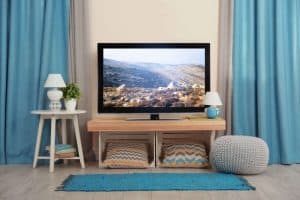Television is part of the fabric of our modern homes, and your new TV could be your family’s best friend for years to come. So, this isn’t like buying a kettle or a toaster, and you’re going to want to get it right the first time. After all, you’ll spend thousands of hours watching it, it’s worth spending a few picking the right one.
So, how do you choose a great TV?
Size:
There was a time when the size of the sofa, or the surface to stand the set on, dictated the size of the TV, but not anymore. With wall mounted screens, wider viewing angles and vastly improved image quality, size is much less of an issue. However, there are a few points to bear in mind.
A large room can easily carry off a big screen, such as a 70-inch tv or 65-inch tv set, especially if wall mounted. They possess an awe inspiring immersitivity that pulls you in and refuses to release you until the very end of the movie – that cinematic experience right in your living room. All you need is the popcorn. As for watching the big game, it’ll blow your socks and shoes off!
For an average sized room, there are some great TVs designed for those, too. A sleek framed 55-inch tv set, or a 50-inch, one will suit this room perfectly. Not too big and not too small, it can easily fit on an empty stretch of wall, or on a TV unit, without fear of getting in the way.
It’s becoming increasingly popular to have a TV in the bedroom or kitchen, and for this situation, a 40-inch tv model, or smaller tv could be just what you’re looking for. Less intrusive and space consuming, they are ideal for watching while you cook, or dozing off to sleep.
Screen Resolution:
Resolution describes the number of pixels that make up the picture on a display, described in terms of horizontal rows and vertical columns. The more pixels, generally the better the image quality.
Let’s get this out of the way first – 4K TVs and Ultra HD are close enough to being the same thing that, essentially, there is no difference. They both have a resolution of 3840 x 2160 pixels – that’s over 8 million pixels, compared to HDTV, which has 1 million. The biggest benefit of the increased pixel count is that small objects displayed on the screen have much more detail, and any text is sharper. Overall, images appear richer and more realistic than on an HDTV. These benefits can be subtle and it’s only when viewed side by side that you’d consciously notice the difference.
HDR:
High dynamic range, or HDR, is a reference to the ability to deliver more colours, more vibrancy and more contrasts. Textural contexts are sharper and more clearly defined, and generally, the image is much more realistic. Many 4K TVs come with this as standard.
LED-LCD and OLED:
The majority of televisions today are LED LCD. These sets use light-emitting diodes (LEDs) to illuminate the LCD screen and TV sets can be extremely thin. The benefit is that these TVs can dynamically light up specific areas of the screen, and dim others, making a scene realistic and true to life. This is known as active dimming or local dimming.
Going one better, with OLED TVs every single pixel (and we’re talking 8,847,360 pixels in all) turns on and off, adjusting on its own. As you can imagine, this brings a whole new depth. Colours pop, black is the truest richest black, and contrast and shadow detail are incredible.
Smart TVs:
An increasing number of sets have built-in WiFi for connecting to internet-based services and are able to download on-demand movies, games and access social media.
These smart TVs make it possible to get rid of your cable or satellite service, thanks to the native apps they come with. Allowing access to streaming services such as Netflix, Prime, YouTube and Amazon Prime Video, they also enable you to view pretty much any content on your TV, including all the home videos, photos, and music on your phone or computer.
Hopefully, shedding some light on the technology involved in today’s TVs has made it a little bit easier to buy your next TV.














